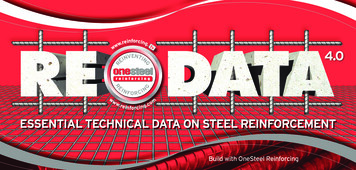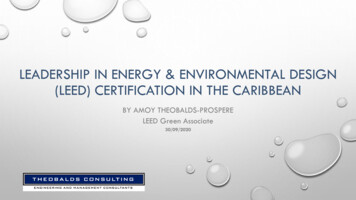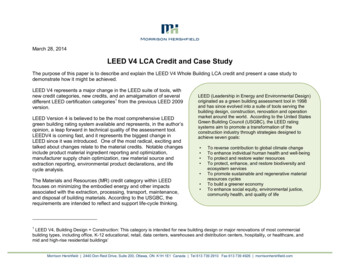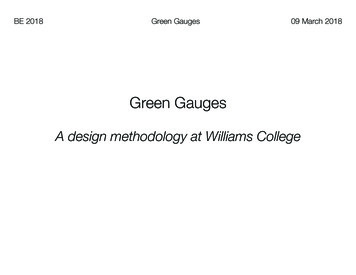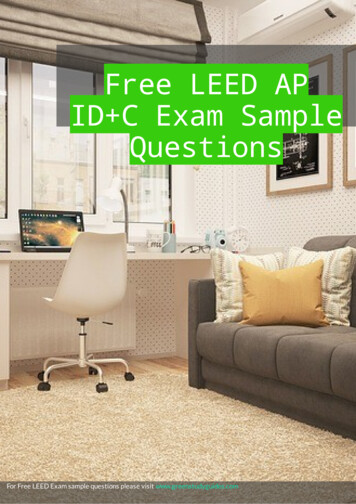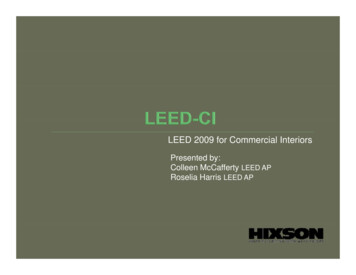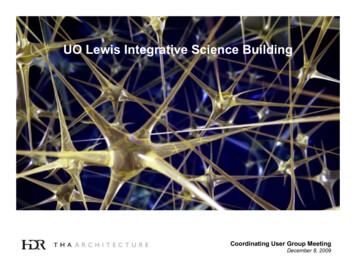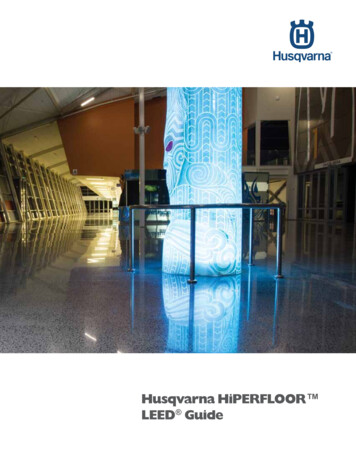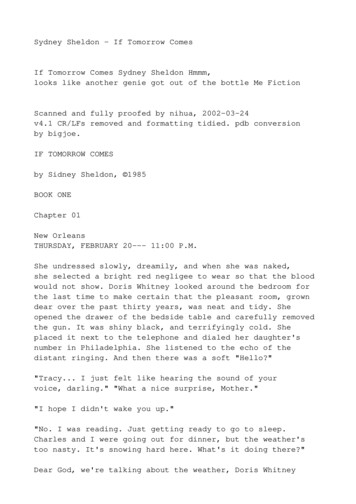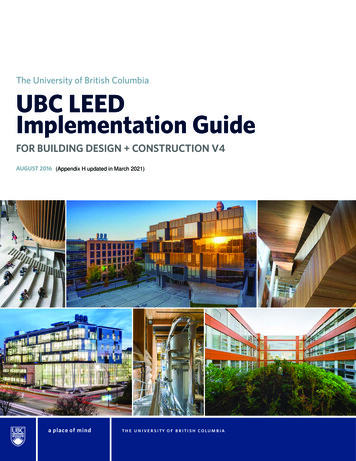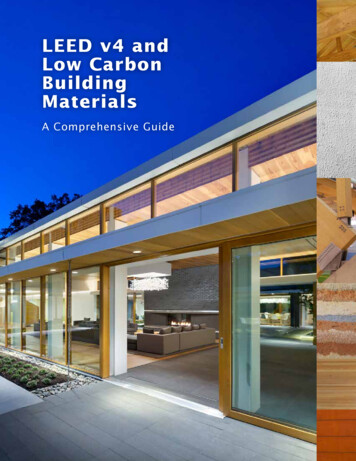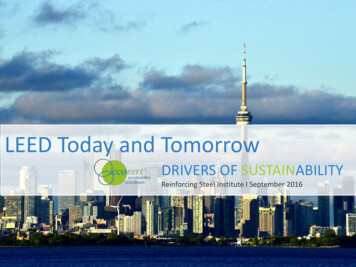
Transcription
LEED Today and TomorrowDRIVERS OF SUSTAINABILITYReinforcing Steel Institute I September 2016
Learning Objectives1. Understanding of the LEED Ratingsystem2. Understanding of the changes toLEED with the introduction of LEEDVersion 43. Understanding of EnvironmentalProduct Declarations and their rolein LEED4. Highlight some of the LEED creditsrelating to reinforcing steel
LEARNING OBJECTIVES1. WHAT is LEED?2. WHY is LEED relevant?3. LEED and Reinforcing Steel1. Where we were.2. Where we are.3. Where we are going.4. Beyond LEED5. Questions3
ECOVERTSUSTAINABILITYCONSULTANTS
BMW CORPORATE HEADQUARTERSRichmond Hill, OntarioBUILDING FEATURES LEED Silver Certified Designed for maximizedcomfort & flexibility Raise floor system withoperable windows Light shelves andautomated blinds tomaximize daylighting47% WATERSAVINGS38% ENERGYSAVINGS57% REGIONALMATERIALS
WOMENS COLLEGEToronto, OntarioWOMENS COLLEGE HOSPITALToronto, OntarioBUILDING FEATURES Targeting LEED Silver Designed to maximizedaylighting. Over 20% of site areaset aside for greenspaces & roof gardensto promote healing Electric vehicle parking& charging stations40% WATERSAVINGS33% ENERGYSAVINGS20% RECYCLEDCONTENTEarth Rangers Centre
QUEEN RICHMOND CENTRE WESTToronto, OntarioQUEEN RICHMOND STREET WESTToronto, OntarioBUILDING FEATURES Targeting LEED Gold Raised floor design Operable windows forincreased tenant comfort Grey water conveyance35% WATERSAVINGS45% ENERGYSAVINGS90% WASTEDIVERSION
EARTH RANGERS EDUCATION CENTREEARTH RANGERSWoodbridge, OntarioWoodbridge, OntarioBUILDING FEATURES LEED Platinum Cert. ENERGY STAR rating of 95 Geothermal systems Photovoltaic systemcovering surface parkingarea Earth tubes On site water treatment60% WATERSAVINGS79% ENERGYSAVINGS70% REDUCTION ONGOINGCONSUMABLES
What is theLEED Rating System?
OVERVIEW OF LEEDHistory and Growth of LEEDLeadership in Energy & Environmental Design World-recognized 3rd party rating systems.Distinguishes top 15% of high performance buildings.U.S. Green Building Council (USGBC) formed in 1993.Rating Systems adopted by the Canada Green Building Council (CaGBC)in 2001. LEED Version 4 launched November 2013 and mandatory as of October201610
GROWTH OF LEEDHistory and Growth of LEED Preeminent global green building program and is in use in over 140countries More than 3.3 billion square feet of space has been certified under LEED Over 1.7 million SF of building space certified daily140 1.7COUNTRIESMILLION SFSource: USGBC Green Building Facts, 17 Oct 2014 and USGBC Press Release, 8 April 2014
LEED RATING SYSTEMS4 Certification Levels
Why are so manybuildings certifyingunder the LEEDprogram?
GROWTH OF LEEDStudy of the 30 largest markets in the U.S. found that: At the end of 2013, commercial buildings certified by LEEDrepresented 5.1% of the total market [up from 0.1% at theend of 2005] Measured by floor area, LEED-certified space representedalmost one-fifth (19.4%) of the total commercial officemarket.Source: CBRE, National Green Building Adoption Index, 2014
BENEFITS OF GREEN OFFICES2016-12-07www.ecovert.ca15
BOTTOM LINE BENEFITS OF GREEN BUILDINGSFinancial Reduce Life-Cycle Costs Lower Insurance Rates Energy Risk Reduction Reduced/Easier ChurnProductivity Reduced Absenteeism Recruitment Tool Improved Employee MoraleCorporate Citizenship International Recognition Increased Sales and Marketability
FINANCIAL BENEFITS OF PRODUCTIVITY INCREASECarnegie Mellon Studies have shown that productivity increasesrange from 0.4% to 18%Average cost of a US office BuildingSalaries 318.00 per SFTechnology50.00 per SFLease / Mortgage32.00 per SFEnergy2.35 per SFTotal 402.35 per SFFindings:1% increase 3.18 per SF savings5% increase 15.90 per SF savings
BOTTOM LINE BENEFITS OF GREEN BUILDINGSFinancial Reduce Life-Cycle Costs Lower Insurance Rates Energy Risk Reduction Reduced/Easier ChurnProductivity Reduced Absenteeism Recruitment Tool Improved Employee MoraleCorporate Citizenship International Recognition Increased Sales and Marketability
LEED vs Non-LEED STUDY CONCLUSIONS Buildings with a green rating (LEED or Energy Star) command rentalrates that are roughly 3 percent higher per square foot thanotherwise identical buildings — controlling for the quality and thespecific location of office buildings. Premiums in effective rents are even higher — above7 percent. Selling prices of green buildings are higher by about 16percent.Source: KANAI, & ORTEGA-ALCÁZAR, 2009
LEED andSteel
HOW FOREST PRODUCTS ARE RECOGNIZED IN LEEDWHERE WE WERELEED Version 1 (released 2007): Credits that encourage use of forest products: MRc5: Regional Materials (1-2 points)MRc6: Rapidly Renewable Materials (1 point)MRc7: Certified Wood (1 point)EQc4.4: Low-Emitting Materials: Composite Wood andAgrifiber Products (1 point)
HOW FOREST PRODUCTS ARE RECOGNIZED IN LEEDWHERE WE ARELEED 2009 (released 2010): Credits that encourage use of steel products: MRc2: Construction Waste Management (1-2 points)MRc5: Regional Materials (1-2 points)
HOW FOREST PRODUCTS ARE RECOGNIZED IN LEEDWHERE WE ARE GOINGLEED Version 4 (released 2013): Credits that encourage use of forest products: MRc1: Building Lifecycle Impact Reduction – Life CycleAssessment (3 points)MRc2: Building Product Disclosure and Optimization:Environmental Product Declarations (1 point)MRc3: Building Product Disclosure and Optimization:Sourcing of Raw Materials (1 point)MRc4: Building Product Disclosure and Optimization:Material Ingredients (1 point)EQc2: Low-Emitting Materials (1-3 points)
HOW FOREST PRODUCTS ARE RECOGNIZED IN LEEDNEW LEED VERSION 4 CREDIT:MRc1: Building Lifecycle Impact ReductionCredit Requirements: Whole building lifecycle assessment demonstrating 10% reductionin at least 3 out of 6 impact categories (e.g. global warmingpotential)Steel Contribution: The LCA incentivizes materials with comparatively lowenvironmental impact.
HOW FOREST PRODUCTS ARE RECOGNIZED IN LEEDWhat is an LCA?Life cycle assessment – a comprehensive analysisthat provides a more complete understanding of aproduct’s total impact. LCAs account for all thematerials, processes, and services that go intomaking and using a product. These also show thebalance between all phases of a product’s life –from raw material acquisition through todisassembly and disposal of components.
HOW FOREST PRODUCTS ARE RECOGNIZED IN LEEDLCA Credit Impact CategoriesGlobalWarmingDepletionof eFormationAcidificationEutrophication
HOW FOREST PRODUCTS ARE RECOGNIZED IN LEEDLCA Impact Example: Environmental Performance for SteelThis sample eLCie System Spidergram chart, produced as part of a life cycleanalysis, summarizes a product’s environmental impact in a number of keyareas, compared to an industry average.GlobalWarmingWaste100%Ozone EutrophicationHigh RecycledContent Steel
HOW FOREST PRODUCTS ARE RECOGNIZED IN LEEDNEW LEED VERSION 4 CREDIT:MRc2: Building Product Disclosure and Optimization:Environmental Product DeclarationsCredit Requirements: Use at least 20 different permanently installed products sourcedfrom at least five different manufacturers that meet one of thedisclosure criteria: Environmental Product Declarations OR ProductSpecific Declaration.Steel Contribution: Wood products with environmental product declarationscontribute toward this credit.
HOW FOREST PRODUCTS ARE RECOGNIZED IN LEEDWhat is an Environmental Product Declarations?The goal of an Environmental Product Declaration (EPD) is to provide relevant,verified and standardized information about the environmental impact of a product orsystem. Think of these as the declared unit/serving size like on a nutritional label.EPDs are reports compiled from an LCA and developed according to the rules asdefined by PCRs for the specific product.
HOW FOREST PRODUCTS ARE RECOGNIZED IN LEEDNEW LEED VERSION 4 CREDIT:MRc3: Building Product Disclosure and Optimization: Sourcing ofRaw MaterialsCredit Requirements: OPTION 1: Use at least 20 different permanently installed productsfrom at least 5 different manufacturers that have publicly released areport from their raw material suppliers.Wood Contribution: OPTION 1: Wood from suppliers and manufacturers with aCorporate Sustainability Report contribute.
HOW FOREST PRODUCTS ARE RECOGNIZED IN LEEDNEW LEED VERSION 4 CREDIT:MRc3: Building Product Disclosure and Optimization: Sourcing ofRaw MaterialsCredit Requirements: OPTION 2: Use products that meet at least 1 of the responsibleextraction criteria for at least 25%, by cost, of the total materialscost.Wood Contribution: OPTION 2: New wood products with the FSC or SustainableAgriculture Network labels (or equivalent standard) contribute.Under the new pilot ACP, wood certified under programs meetingASTM D7612-10 also count, when threshold conditionsare met, such as 100% of wood must be legally harvested.
HOW FOREST PRODUCTS ARE RECOGNIZED IN LEEDNEW LEED VERSION 4 CREDIT:MRc4: Building Product Disclosure and Optimization: MaterialIngredientsCredit Requirements: OPTION 1: Material Ingredient Reporting (to at least 0.1%) OPTION 2: Material Ingredient Optimization OPTION 3: Product Manufacturer Supply Chain Optimization(robust programs and processes to ensure safety and health andreduce hazards and risks).Steel Contribution: An EPD will help in satisfying these requirments.
HOW FOREST PRODUCTS ARE RECOGNIZED IN LEEDNEW LEED VERSION 4 CREDIT:EQc2: Low-Emitting MaterialsCredit Requirements: Flooring: Prefinished wood flooring must comply with CaliforniaDepartment of Public Health Standard Method v1.1-2010. Composite Wood: Must meet CARB ATCM for formaldehyderequirements for ultra-low-emitting formaldehyde (ULEF) resins orno added formaldehyde (NAF) resins.Wood Contribution: Flooring: Untreated and unfinished wood is classified as aninherently non-emitting source and can contribute.
HOW FOREST PRODUCTS ARE RECOGNIZED IN LEEDMORE POINTS FOR REGIONAL MATERAILS:Building Product Disclosure and Optimization CreditsWood Contribution: Triple-bottom line benefits of locally harvested, manufacturedmaterials Purchasing locally (within 160km from project site) helps projectteams meet the performance thresholds in all three of the BPDOLEED credits, helping projects earn up to three points.
Beyond LEED
BEYOND LEEDOTHER GREEN BUILDING PROGRAMS AND WOODLiving Building Challenge:WELL Building Standard:
Thank You
ECOVERTSUSTAINABILITYCONSULTANTS
Contact UsEcovert Sustainability Consultants55 Ormskirk AvenueSuite 100Toronto, ON. M6S 4V6Jim Lord – Principaltel: 416 987 0285email: jim.lord@ecovert.caJames Donath – Directortel: 416 204 0152email: james.donath@ecovert.ca
LEED vs Non-LEED STUDY CONCLUSIONS Buildings with a green rating (LEED or Energy Star) command rental rates that are roughly 3 percent higher per square foot than otherwise identical buildings — controlling for the quality and the specific location of office buildings. Premi
